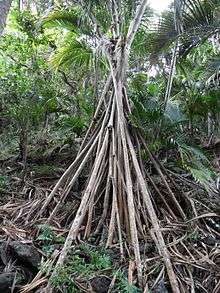Pandanus forsteri
| Pandanus forsteri | |
|---|---|
 | |
| Scientific classification | |
| Kingdom: | Plantae |
| (unranked): | Angiosperms |
| (unranked): | Monocots |
| Order: | Pandanales |
| Family: | Pandanaceae |
| Genus: | Pandanus |
| Species: | P. forsteri |
| Binomial name | |
| Pandanus forsteri C.Moore & F.Muell. (1874)[1] | |
Pandanus forsteri , commonly known as Forky-Tree or Forkedy-Tree, is a flowering plant in the screwpine family. The specific epithet honours either Johann Forster or Georg Forster, father and son German botanists, who accompanied James Cook as naturalists on his second voyage (1772–1775).[1]
Description
It is an unmistakable tree growing to 13 m in height, characterised by wart-like outgrowths and prop roots up to 5 m long. The strap-shaped leaves are 1–1.5 m long and 3–5 cm wide, spiny along the edges and beneath the midrib. The tiny female flowers are covered by leaves; male flowers are borne on 50 cm long inflorescences enclosed in white spathaceous bracts. The fruits occur as dense spheroidal clusters about 20 cm across, red when ripe. The flowering season is from December to April.[1][2]
Distribution and habitat
The species is endemic to Australia’s subtropical Lord Howe Island in the Tasman Sea, where it is common from sea level to an elevation of about 400 m.[1]
References
- 1 2 3 4 " Pandanus forsteri ". Flora of Australia Online: Data derived from Flora of Australia Volume 49 (1994). Australian Biological Resources Study (ABRS). Retrieved 2014-02-13.
- ↑ Hutton, Ian (1998). The Australian Geographic Book of Lord Howe Island. Sydney: Australian Geographic. p. 136. ISBN 1-876276-27-4.